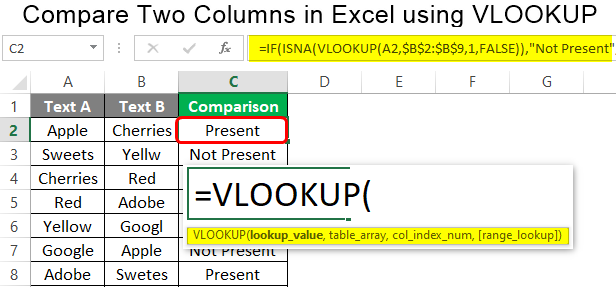Master the Art of Comparing Excel Columns: Different Sheets

Comparing data across multiple columns in different sheets within Microsoft Excel can streamline your data analysis, reduce manual errors, and save time. Whether you're managing inventory, tracking sales, or conducting any data-intensive task, mastering the techniques to compare Excel columns across sheets is crucial. This post will guide you through various methods, tips, and best practices to help you become proficient in this essential skill.
Understanding Excel Sheets and Columns

Before we dive into the comparison methods, let’s get a brief understanding of Excel sheets and columns:
- Workbook: An Excel file which contains one or more sheets.
- Sheet: A single page within a workbook, also known as a worksheet, where you can enter and manipulate data.
- Columns: Vertical cells labeled with letters from A to XFD (in Excel 2010 and later).
- Rows: Horizontal cells numbered from 1 to 1,048,576 (in Excel 2010 and later).
Method 1: Using VLOOKUP for Simple Comparisons


VLOOKUP, or Vertical Lookup, is one of the simplest yet powerful functions to compare data:
- Select a cell where you want the result to appear.
- Enter the VLOOKUP formula:
=VLOOKUP(lookup_value, table_array, col_index_num, [range_lookup]). lookup_valueis the value you want to search for in the first column of thetable_array.table_arrayis the range where you want to look for the lookup value, usually from another sheet.col_index_numis the column number from where you want to pull the data.range_lookupis optional; set to FALSE for an exact match or TRUE for an approximate match.
Method 2: Conditional Formatting for Visual Comparison


Conditional formatting can visually highlight differences and similarities:
- Select the data range you want to compare.
- Go to ‘Home’ > ‘Conditional Formatting’ > ‘New Rule’.
- Choose ‘Use a formula to determine which cells to format’.
- Enter a formula like:
=A2<>Sheet2!A2to highlight differences.
Here’s how the formula works:
- A2 refers to a cell in the active sheet.</li> <li>Sheet2!A2 refers to the corresponding cell in another sheet.
Method 3: Power Query for Advanced Comparisons


Power Query provides robust tools for merging, transforming, and comparing data from different sources:
- Go to the ‘Data’ tab, select ‘Get Data’ > ‘From Other Sources’ > ‘From Microsoft Query’.
- Select ‘Excel Files’ and choose your workbook.
- Choose the sheets you want to compare and click ‘Next’.
- In the Query Editor, use ‘Merge Queries’ to join data based on common columns.
Power Query can be complex but offers unparalleled flexibility for sophisticated data comparisons.
Method 4: Using INDEX-MATCH for More Flexibility


The INDEX-MATCH function can serve as an alternative to VLOOKUP, offering more flexibility:
- Use
=INDEX(array, MATCH(lookup_value, lookup_array, [match_type])) arrayis the range of cells to return the result from.MATCHfunction finds the position oflookup_valuewithinlookup_array.
Notes:

💡 Note: INDEX-MATCH is more flexible than VLOOKUP since it doesn’t require the lookup value to be in the first column of the table_array.
Method 5: Comparing Multiple Columns with Array Formulas

Array formulas allow you to perform complex calculations involving multiple columns at once:
- Enter
=IF(Sheet1!A2:A100=Sheet2!A2:A100, “Match”, “No Match”)and press Ctrl + Shift + Enter to create an array formula. - This formula will compare each row of both sheets and return “Match” or “No Match”.
To wrap up, mastering the art of comparing Excel columns from different sheets can significantly enhance your data analysis capabilities. From simple VLOOKUP functions to advanced Power Query techniques, there are multiple ways to achieve your goal, each suited to different scenarios. By understanding these methods and when to apply them, you'll be well-equipped to manage, analyze, and interpret complex data sets with ease. Moreover, employing visual tools like Conditional Formatting can make discrepancies jump out at you, facilitating quick identification of anomalies or inconsistencies. Keep in mind that practice and understanding your data structure will play a crucial role in how effectively you use these comparison techniques.
What is the main difference between VLOOKUP and INDEX-MATCH?

+
VLOOKUP searches for a value in the first column of a table array and returns a value from the same row in a specified column. INDEX-MATCH, however, uses two functions; INDEX returns the value at a given position in a range, and MATCH finds the position of a lookup value within a lookup array, making it more flexible in terms of column placement.
How can I compare two Excel files instead of sheets?

+
You can use Power Query or VBA scripting to compare data from different workbooks. Power Query can open external files and merge data, while VBA provides more customization for file comparison.
Can I automate the comparison process in Excel?

+
Yes, with tools like Power Query, you can create queries that automatically update when data changes, or you can write VBA macros to automate repetitive comparison tasks.
Are there any limitations to the number of columns I can compare?

+
The practical limitation comes from Excel’s file size and performance; however, Excel 2010 and later support up to XFD columns (16384 columns). For very large datasets, you might want to consider database software like SQL.
What’s the fastest way to highlight duplicates across sheets?

+
Using conditional formatting with an appropriate formula or utilizing Power Query to merge sheets and then highlighting duplicates with formatting rules can be very efficient.